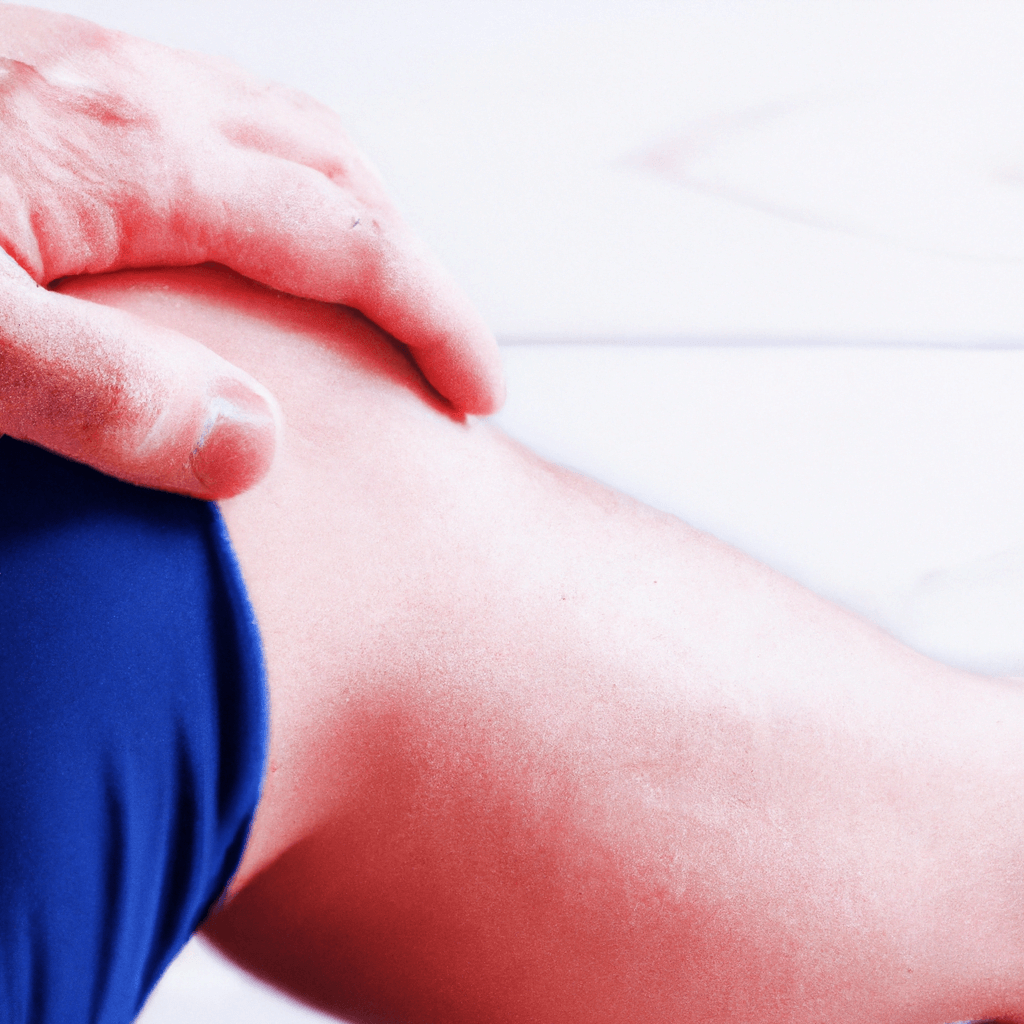Treating Sports Injuries With Heat And Ice
Treating Sports Injuries With Heat And Ice explores the highly effective therapeutic techniques of heat and ice in managing and healing sports-related injuries. This article presents a comprehensive overview of the benefits, applications, and correct usage of heat and ice in treating various types of injuries commonly encountered in sports. By understanding the physiological effects of these contrasting temperature therapies, you will gain valuable insights into optimizing recovery and facilitating the return to peak performance for athletes of all levels.

Heat Therapy
Introduction
Heat therapy, also known as thermotherapy, is a common method used to alleviate pain and promote healing in sports injuries. By increasing blood circulation, heat therapy helps relax muscles, reduce muscle spasms, and relieve stiffness. This comprehensive article will explore how heat therapy works, its benefits, different types and techniques, precautions, and considerations. Understanding the various aspects of heat therapy will enable you to make informed decisions when incorporating it into your sports injury treatment plan.
How Heat Therapy Works
Heat therapy works by applying heat to the injured area, which triggers several physiological responses in the body. Firstly, heat increases blood flow to the affected area. This increased circulation delivers oxygen and essential nutrients to the injured tissues, aiding in the healing process. Additionally, heat helps to relax the muscles and tissues surrounding the injury, reducing muscle spasms and relieving tension. Heat therapy also raises the pain threshold, providing temporary relief from pain and discomfort.
Benefits of Heat Therapy
Heat therapy offers numerous benefits for sports injuries. The increased blood circulation induced by heat promotes the delivery of oxygen and nutrients to the injured tissues, accelerating the healing process. Heat therapy also helps alleviate muscle spasms by relaxing the muscles, reducing stiffness and pain. Furthermore, heat can enhance joint flexibility, making it an effective treatment option for chronic conditions such as arthritis. Additionally, heat therapy provides psychological comfort to individuals experiencing pain, allowing them to relax and improve their overall well-being.
Types of Heat Therapy
There are various types of heat therapy that can be used to treat sports injuries. Dry heat therapy, such as heating pads or hot water bottles, involves applying heat to the injured area without moisture. Moist heat therapy, including warm compresses or warm baths, utilizes moist heat to deliver therapeutic effects. Both methods have their own advantages and can be selected based on individual preferences or the type and severity of the injury. It is important to consult with a healthcare professional or a certified athletic trainer to determine the most suitable type of heat therapy for your specific condition.
Heat Therapy Techniques
Heat therapy techniques can be applied through a variety of methods, each offering unique benefits. Hot water bottles and heating pads provide localized heat and are commonly used for muscle strains or joint pain. Warm baths and showers allow for full-body heat therapy and can help relax the entire musculoskeletal system. Hot towels and warm compresses are beneficial for injuries requiring continuous heat application, such as tendonitis or bursitis. It is important to follow proper heat therapy techniques to ensure maximum effectiveness and minimize the risk of burns or other complications.
Precautions and Considerations
While heat therapy can be highly beneficial, it is crucial to exercise caution and consider certain factors before initiating treatment. It is generally recommended to avoid heat therapy immediately after an acute injury or if the injured area is swollen or bruised. Heat should also be used with caution for individuals with certain medical conditions, such as diabetes, circulatory problems, or dermatological conditions. Additionally, it is important to monitor the duration and temperature of heat therapy to prevent burns or aggravation of the injury. Consulting a healthcare professional or athletic trainer is advisable to ensure appropriate use of heat therapy in your specific case.
Ice Therapy
Introduction
Ice therapy, also known as cryotherapy, is a popular method for treating sports injuries. By applying cold temperatures to the affected area, ice therapy helps reduce pain, inflammation, and swelling. This section will provide a comprehensive overview of how ice therapy works, its benefits, different types and techniques, as well as precautions and considerations to keep in mind when using ice therapy as part of your sports injury treatment plan.
How Ice Therapy Works
Ice therapy works by constricting blood vessels, reducing blood flow to the injured area, and decreasing metabolic activity. This constriction helps reduce inflammation, swelling, and pain associated with sports injuries. Cold temperatures also numb the nerves, temporarily numbing the area and providing pain relief. Moreover, ice therapy slows down the conduction of nerve impulses, reducing muscle spasms and promoting muscle relaxation.
Benefits of Ice Therapy
Ice therapy offers several benefits for sports injuries. Its ability to reduce inflammation and swelling makes it highly effective in the immediate aftermath of an acute injury. By decreasing blood flow and numbing the area, ice therapy provides pain relief and helps manage discomfort during the recovery process. Ice therapy also aids in controlling and preventing further tissue damage by reducing metabolic activity and constricting blood vessels. Incorporating ice therapy into your sports injury treatment plan can significantly enhance healing and expedite the road to recovery.
Types of Ice Therapy
There are multiple types of ice therapy available for treating sports injuries. Ice packs, typically filled with ice or frozen gel, are the most commonly used form of ice therapy. Cold packs, which contain a gel that remains flexible even when frozen, provide the advantage of conforming to the contours of the injured area. Ice massage involves directly applying ice to the skin in a circular motion, targeting specific muscles or trigger points. Cold water immersion, where the injured area is submerged in ice water, is used for larger regions or joints. Each type of ice therapy has its own advantages and can be tailored to meet individual needs and preferences.
Ice Therapy Techniques
Ice therapy techniques involve various methods of applying cold temperatures to the injured area. Ice packs are typically applied for short durations, ranging from 10 to 20 minutes, ensuring that the cold does not cause tissue damage. Ice massage is usually performed for 5 to 10 minutes, gradually increasing the duration as tolerated. Cold water immersion is typically carried out for 10 to 15 minutes, making sure to monitor the skin’s tolerance to cold temperatures. It is essential to follow proper ice therapy techniques and guidelines to achieve optimal results and avoid any potential complications.
Precautions and Considerations
Although ice therapy is generally safe and effective, it is important to exercise caution and consider certain factors before using it. Avoid applying ice directly to the skin, as this can cause frostbite or tissue damage. Always use a barrier, such as a towel or cloth, between the ice and the skin. Ice therapy should be avoided in individuals with known cold allergies, circulation problems, or sensation deficits. It is also essential to monitor the duration and frequency of ice therapy to prevent skin damage, especially in individuals with pre-existing skin conditions. Seeking advice from a healthcare professional or athletic trainer will help ensure the safe and effective use of ice therapy in your specific case.
When to Use Heat or Ice
Acute Injuries vs. Chronic Injuries
The choice between heat or ice therapy depends on the nature of the injury. Acute injuries, such as sprains or strains, occur suddenly and are often accompanied by inflammation, swelling, and sharp pain. In these cases, ice therapy is typically the initial treatment of choice. Conversely, chronic injuries, which develop over time, often involve muscle tightness, stiffness, and a dull, persistent pain. Heat therapy is generally more suitable for chronic injuries as it helps relax muscle tightness, improve blood flow, and relieve stiffness.
Inflammation and Swelling
Inflammation and swelling are common symptoms of sports injuries, particularly in acute conditions. Ice therapy is recommended for reducing inflammation and swelling by constricting blood vessels and decreasing blood flow. Applying ice at regular intervals can help manage these symptoms effectively. Heat therapy, on the other hand, should be avoided during the initial stages of injury when inflammation and swelling are prominent, as heat can exacerbate these symptoms.
Muscle Spasms and Muscle Tightness
Muscle spasms and tightness often accompany sports injuries, contributing to pain and limited range of motion. Heat therapy is beneficial in relaxing muscles, reducing muscle spasms, and improving flexibility. By increasing blood flow and promoting muscle relaxation, heat therapy can alleviate muscle tightness commonly associated with chronic injuries. Ice therapy may help in situations where muscle spasms are acute and accompanied by inflammation or swelling.
Pain and Pain Relief
Both heat and ice therapy can provide pain relief, but the choice between the two depends on the injury and its stage. Ice therapy is typically effective in reducing pain caused by acute injuries, as cold temperatures numb nerves and provide temporary relief. Heat therapy, however, is more suitable for addressing dull or persistent pain associated with chronic injuries. It is important to evaluate the severity and nature of the pain to determine the most appropriate treatment.
Choosing the Right Treatment
Selecting the appropriate treatment, whether heat or ice therapy, requires careful consideration of the injury characteristics and symptoms. Consulting with a healthcare professional or a certified athletic trainer is highly recommended to create an individualized treatment plan. They can provide an accurate diagnosis and expert guidance on when and how to use heat or ice therapy based on the specific injury, its severity, and the stage of the healing process.
Common Sports Injuries that Benefit from Heat or Ice
Sprains and Strains
Sprains and strains are common sports injuries that often involve damage to ligaments or muscles. Both heat and ice therapy can be beneficial in managing the pain and inflammation associated with these injuries. During the early stages, when there is acute inflammation and swelling, ice therapy should be applied. As the injury progresses into the healing phase, heat therapy can aid in relaxing muscles, reducing stiffness, and promoting blood flow to facilitate tissue repair.
Muscle Cramps
Muscle cramps can occur during or after intense physical activity, causing sudden and painful contractions. Ice therapy can be used to provide immediate relief by numbing the affected area and reducing muscle spasms. Applying ice packs or using ice massage techniques can help alleviate the pain and relax the cramped muscle. It is usually more effective to apply ice therapy during or immediately after the cramp occurs.
Tendonitis
Tendonitis, characterized by inflammation of a tendon, is often caused by repetitive motions or overuse. In the acute stages of tendonitis, ice therapy is recommended to reduce inflammation and provide pain relief. As the condition progresses into the subacute or chronic phase, heat therapy can be beneficial in reducing muscle tightness, promoting blood circulation, and enhancing flexibility. It is important to adjust the treatment approach based on the severity and stage of the tendonitis.
Bursitis
Bursitis is the inflammation of a bursa, a fluid-filled sac that cushions the joints. Ice therapy is commonly used in the acute stages of bursitis to reduce inflammation and swelling. As the condition progresses into the subacute or chronic phase, heat therapy can aid in relieving pain, reducing muscle tension, and increasing joint mobility. A combination of both heat and ice therapy may be recommended, depending on the severity and stage of bursitis.
Contusions and Bruises
Contusions, commonly referred to as bruises, occur when blood vessels beneath the skin rupture due to direct impact or trauma. Ice therapy is typically the treatment of choice for reducing pain and swelling associated with contusions. Applying ice packs or cold compresses immediately after the injury helps constrict blood vessels, minimizing blood flow and decreasing the size of the bruise. Once the acute swelling has subsided, heat therapy may be beneficial in promoting the absorption of trapped blood and accelerating the recovery process.

Heat and Ice Application Techniques
Moist Heat vs. Dry Heat
Heat therapy can be classified into two main categories: moist heat and dry heat. Moist heat involves using heat sources that contain moisture, such as warm compresses or warm baths. Dry heat is applied using sources such as heating pads or hot water bottles, which do not have moisture. Both moist heat and dry heat therapy are effective, and the choice between them can be based on individual preferences or the specific injury being treated.
Hot Water Bottles and Heating Pads
Hot water bottles and heating pads are commonly used items for applying heat therapy. The warm temperature provided by hot water bottles or heating pads penetrates into the muscles, promoting relaxation and relieving pain. They can be easily applied to the affected area and are particularly useful for localized pain, such as muscle strains or joint stiffness. It is important to maintain a comfortable temperature and use a protective layer, such as a towel, to prevent burns or skin damage.
Warm Baths and Showers
Warm baths and showers are effective methods of applying heat therapy to larger areas of the body. Submerging the injured area in warm water increases blood flow, relaxes the muscles, and reduces stiffness. Warm baths and showers are particularly beneficial for chronic injuries or conditions affecting multiple joints or muscle groups. It is essential to ensure a safe water temperature and avoid using excessively hot water to prevent burns or scalds.
Hot Towels and Warm Compresses
Hot towels and warm compresses are convenient and versatile heat therapy techniques that can be used for various types of sports injuries. They are particularly suitable for injuries that require continuous heat application, such as tendonitis or bursitis. Hot towels or warm compresses can be easily applied to the affected area and can provide localized heat for as long as needed. It is important to maintain a comfortable temperature and periodically check the skin for any adverse reactions.
Cold Packs and Ice Packs
Cold packs and ice packs are essential tools for ice therapy. They are commonly filled with ice or frozen gel and can be easily applied to the injured area. Cold packs and ice packs provide localized cold therapy, constricting blood vessels and reducing inflammation and swelling. They should be wrapped in a cloth or towel before applying to the skin to prevent direct contact and minimize the risk of frostbite or tissue damage.
Ice Massage and Ice Baths
Ice massage and ice baths are effective techniques for applying cold temperatures to the body. Ice massage involves directly rubbing ice cubes or an ice pack on the skin in a circular motion over the affected area. It helps in reducing pain, numbing the area, and relieving muscle spasms. Ice baths, on the other hand, involve immersing the injured area in a container filled with ice water. Ice massage and ice baths are particularly suitable for larger regions or joints that require cooling over an extended area.
Cold Water Immersion
Cold water immersion is a technique commonly used by athletes to promote recovery and reduce inflammation. It involves submerging the entire body or a specific body part in cold water, typically ranging from 50 to 59 degrees Fahrenheit (10 to 15 degrees Celsius). Cold water immersion is effective for reducing muscle soreness, inflammation, and accelerating recovery after intense physical activity. It is important to follow proper guidelines and consult with a professional before attempting cold water immersion.
Heat and Ice Combined Therapy
Alternating Heat and Ice
Alternating heat and ice therapy involves using both heat and ice in alternating intervals on the injured area. This technique can be beneficial in managing pain, reducing inflammation, and promoting healing. The alternating temperatures help modulate blood flow and deliver the benefits of both therapies simultaneously. Typically, the sequence starts with heat therapy, followed by ice therapy, with each application lasting for a specific duration. Alternating heat and ice therapy can be particularly useful for chronic injuries or conditions that exhibit both acute and chronic symptoms.
Contrast Therapy
Contrast therapy, also known as hot-cold therapy or hot-and-cold immersion, involves alternating between hot and cold temperatures. This therapy is effective in improving blood circulation, reducing inflammation, and promoting muscle relaxation. The hot temperature dilates blood vessels, while the cold temperature constricts them. This contrast between hot and cold stimulates the circulatory system, resulting in increased blood flow and enhanced tissue repair. Contrast therapy can be accomplished using various methods, such as alternating hot and cold packs or immersing the injured area in hot and cold water.
When to Use Combined Therapy
Combined heat and ice therapy can be used in various situations depending on the characteristics of the injury, symptoms, and individual preferences. Combined therapy is beneficial for chronic injuries or conditions that present a combination of acute and chronic symptoms. It can also be useful during the transition from acute to subacute or chronic stages, where different treatment approaches may be required. Determining the appropriate time to use combined heat and ice therapy should be done on an individual basis with guidance from a healthcare professional or athletic trainer.
Benefits of Combined Therapy
Combined heat and ice therapy offer several benefits by incorporating the advantages of both heat and ice treatment. The application of heat helps relax muscles, reduce stiffness, and improve blood flow, while cold therapy reduces inflammation, swelling, and pain. By alternating between these two therapies, combined therapy provides a comprehensive approach to managing sports injuries. It can enhance the healing process, expedite recovery, and improve overall function. The specific benefits of combined therapy may vary depending on the injury and individual response to treatment.
Safety Precautions
While combined heat and ice therapy can be highly effective, it is important to consider certain safety precautions. Ensure that the temperature extremes are within a safe and comfortable range to prevent burns or frostbite. Monitor the duration of each therapy session to avoid overexposure to hot or cold temperatures. Individual tolerance and skin sensitivity may vary, so it is important to periodically assess the skin’s response and adjust the therapy accordingly. Seeking guidance from a healthcare professional or certified athletic trainer is essential to ensure safe and optimal use of combined heat and ice therapy.

Best Practices for Heat and Ice Treatment
Timing and Duration of Heat or Ice Application
Timing and duration are critical factors in obtaining the maximum therapeutic benefits from heat and ice therapy. For acute injuries, such as sprains or strains, ice therapy should be applied immediately and for the first 48 to 72 hours. After the acute phase, heat therapy can be gradually introduced. Ice therapy sessions typically last for 10 to 20 minutes, while heat therapy sessions can range from 15 to 30 minutes. Longer or more frequent sessions may be needed for chronic injuries. It is important to follow specific guidelines provided by a healthcare professional or athletic trainer for optimal timing and duration of heat or ice application.
Proper Skin Protection
Protecting the skin during heat and ice therapy is crucial to prevent burns or tissue damage. Always use a barrier, such as a towel or cloth, between the heat or ice source and the skin. This barrier helps regulate the temperature and prevents direct contact that may lead to burns or frostbite. Regularly monitor the skin during therapy sessions and discontinue treatment if any adverse reactions, such as redness or pain, are observed. Ensuring proper skin protection is essential for safe and effective heat and ice therapy.
Monitoring and Reassessment
Continually monitoring the progress of the injury and assessing the response to heat and ice therapy is important for evaluating the effectiveness of treatment. If symptoms worsen or persist despite therapy, it may be necessary to reevaluate the treatment approach or consult with a healthcare professional or athletic trainer. Regular reassessment allows for adjustments to the therapy plan and ensures that the chosen treatment method is providing the desired outcomes. Effective monitoring and reassessment help optimize the results of heat and ice therapy.
Combining with Other Treatment Methods
Heat and ice therapy can be used in conjunction with other treatment methods to enhance the healing process and overall recovery. Depending on the specific injury, treatments such as physical therapy, massage, or stretching exercises may be recommended in addition to heat and ice therapy. Combining treatment methods can provide a comprehensive approach that addresses various aspects of the injury, promotes flexibility, strengthens muscles, and supports long-term recovery. Seeking professional advice will help determine the most appropriate combination of treatments for your specific injury.
Seeking Professional Advice
When incorporating heat and ice therapy into your sports injury treatment plan, it is always advisable to seek guidance from a healthcare professional or certified athletic trainer. They have the expertise to accurately diagnose and assess the injury and determine the most appropriate and effective treatment approach. A professional can provide personalized recommendations, ensure proper technique and duration for heat or ice therapy, and monitor the progress of your injury. Seeking professional advice ensures safe and optimal use of heat and ice therapy, enabling you to achieve the best possible outcomes.
Alternative Heat and Ice Treatment Methods
Heat and Ice Creams/Gels
Heat and ice creams or gels are topical treatments that provide localized heat or cold therapy. These creams or gels contain active ingredients that produce either a warming or cooling sensation when applied to the skin. Heat creams or gels often contain ingredients such as capsicum or menthol, while ice creams or gels contain ingredients like camphor or eucalyptus. These topical treatments can be convenient alternatives for heat or ice therapy when traditional methods are not readily available or not preferred. It is important to follow the instructions provided and consult with a healthcare professional before using these creams or gels.
Heat and Ice Wraps
Heat and ice wraps are convenient and easily applicable alternatives for traditional heat or ice therapy. These wraps are designed to provide targeted heat or cold therapy to specific areas of the body. They are often adjustable, allowing for a customized fit and providing compression along with temperature therapy. Heat and ice wraps can be beneficial for individuals requiring mobility while receiving heat or ice treatment. It is important to follow the instructions provided by the manufacturer and consult with a healthcare professional for proper use and to ensure their suitability for your specific injury.
Thermotherapy
Thermotherapy involves using various heat sources to deliver therapeutic effects. Apart from traditional heat therapy methods, thermotherapy encompasses treatments such as infrared lamps, heating pads with infrared technology, or heated paraffin wax baths. These methods use specific wavelengths of light or controlled heat to penetrate deeper into the tissues, enhancing the therapeutic benefits. Thermotherapy can be beneficial for chronic injuries or conditions that require targeted and deep heat penetration. As with any heat therapy, precautions and professional advice should be sought when incorporating thermotherapy into your treatment plan.
Cryotherapy
Cryotherapy involves using extremely cold temperatures for therapeutic purposes. It incorporates treatments such as whole-body cryotherapy chambers, cryospray, or cryotherapy saunas. Cryotherapy is often used by athletes or individuals seeking quick recovery or rejuvenation. It works by rapidly cooling the body, which can reduce inflammation, promote tissue repair, and relieve pain. Cryotherapy should be carried out under the supervision of trained professionals to ensure safety and appropriate exposure to cold temperatures.
Hydrotherapy
Hydrotherapy involves using water, typically warm or cold, for therapeutic purposes. This can include treatments such as whirlpool baths, cold or hot water immersion, or aquatic exercises. Hydrotherapy can provide the benefits of both heat and ice therapy, as warm water promotes relaxation and improved circulation, while cold water aids in reducing inflammation and stimulating the body’s natural healing responses. Hydrotherapy is often used in rehabilitation settings, and it can be a beneficial adjunct to traditional heat and ice therapy. Consulting a healthcare professional or certified aquatic therapist is essential for proper implementation of hydrotherapy.
Electrotherapy
Electrotherapy utilizes electrical currents to provide therapeutic effects. It includes treatments such as transcutaneous electrical nerve stimulation (TENS), ultrasound therapy, or electrical muscle stimulation. These methods can be used for pain relief, muscle relaxation, or enhancing tissue healing. Electrotherapy can often be combined with heat or ice therapy to optimize treatment outcomes. However, electrotherapy should only be administered by trained professionals, as improper use or application can lead to adverse effects. Seeking guidance from a healthcare professional or certified electrotherapist is crucial when considering electrotherapy as part of your sports injury treatment plan.

Preventing Sports Injuries
Proper Warm-Up and Cool-Down
Preventing sports injuries begins with a proper warm-up and cool-down routine. A warm-up includes dynamic stretching, light aerobic exercises, and movements that prepare the body for intense physical activity. It helps increase blood flow, warm up the muscles, and improve flexibility. On the other hand, a cool-down involves static stretching and gentle movements to gradually lower the heart rate and return the body to its resting state. Both warm-up and cool-down routines are important in preventing injuries, improving performance, and aiding recovery.
Appropriate Physical Conditioning
Maintaining appropriate physical conditioning is crucial in preventing sports injuries. Regular exercise that includes strength training, endurance exercises, flexibility training, and balance exercises can enhance muscular strength, endurance, and joint stability. A well-rounded fitness program can help improve overall performance, reduce the risk of injuries, and aid in the recovery from sports-related activities. It is important to work with a qualified fitness professional or coach to develop a tailored conditioning program based on individual goals and sport-specific requirements.
Using Protective Equipment
Using appropriate protective equipment is essential in preventing sports injuries. This includes wearing helmets, mouthguards, pads, braces, or other safety gear designed for specific sports or activities. Protective equipment helps absorb impact, minimize the risk of head or facial injuries, protect joints, and provide support to vulnerable areas. It is important to ensure the proper fit and maintenance of protective equipment to ensure maximum effectiveness. Following sport-specific safety guidelines and regulations is crucial for injury prevention.
Correct Technique and Form
Practicing correct technique and form is vital in preventing sports injuries. Utilizing improper technique can place excessive stress on muscles, joints, and ligaments, increasing the risk of injury. Seeking guidance from a qualified coach, trainer, or instructor is recommended to learn and implement correct techniques for specific sports or activities. Regular practice and feedback can help improve technique and reduce the risk of injury. It is important to listen to the body and refrain from pushing beyond the limits of comfort or capability.
Listening to Your Body
Listening to the body and recognizing the signs of fatigue, pain, or overexertion is essential in preventing sports injuries. Pushing through persistent pain or ignoring warning signs can lead to more serious injuries. Rest and recovery are vital components of any training program, allowing the body to repair, adapt, and strengthen. Adequate rest periods, proper nutrition, and sufficient sleep are important for maintaining overall physical and mental well-being. Giving the body time to recover and replenish is crucial for injury prevention.
Regular Rest and Recovery
Regular rest and recovery are integral parts of any sports injury prevention plan. Overtraining or excessive physical activity without sufficient rest can lead to fatigue, weakened immune function, increased risk of injuries, and impaired performance. Athletes and individuals engaged in physical activities should schedule regular rest days, incorporate active recovery techniques, and ensure adequate sleep. Listening to the body and recognizing the need for rest is important in preventing overuse injuries and promoting long-term health and performance.
Professional Guidance
Seeking professional guidance from healthcare professionals, certified athletic trainers, or sports medicine specialists is vital in preventing sports injuries. These professionals have the knowledge and expertise to assess individual needs, provide personalized recommendations, and identify potential risk factors for injuries. They can create tailored prevention programs, offer advice on proper technique, and help address any underlying issues that may contribute to the risk of injuries. Regular check-ups and evaluations with professionals can help optimize overall health, minimize the risk of injuries, and maximize performance.
Conclusion
Incorporating heat and ice therapy into sports injury treatment plans can significantly contribute to the healing process, pain relief, and overall well-being of individuals. By understanding the mechanisms and benefits of heat and ice therapy, as well as the appropriate usage and alternative treatment methods, individuals can make informed decisions about their own personal recovery. It is crucial to remember that each injury is unique and may require individualized treatment plans. Consulting with healthcare professionals or certified athletic trainers will ensure that the chosen heat or ice therapy is safe, effective, and appropriate for the specific injury, leading to timely recovery and a successful return to sports and physical activities.








